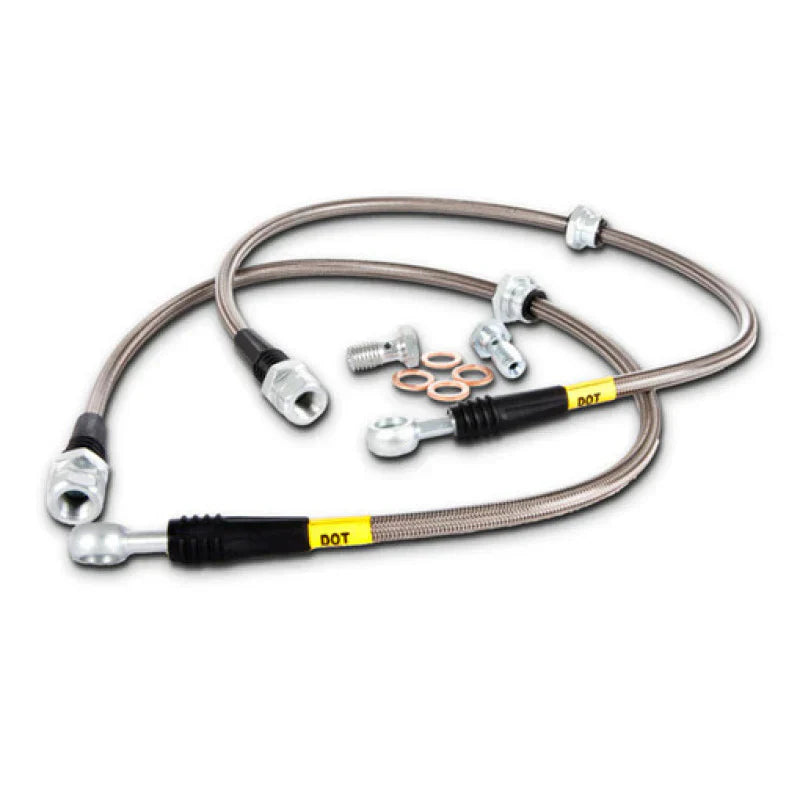
Let’s talk about one of the most overlooked upgrades on a performance car—steel braided brake lines. Not flashy. Not loud. But if you’ve ever hit the middle of a braking zone, mashed the pedal, and gotten that nasty squishy feeling underfoot instead of confidence? Yeah. This one’s for you.
I learned the hard way.
It was a stinking hot day out at Wakefield. I was halfway through my fourth session, cooking the brakes into every downhill corner. First few laps were golden. Firm pedal. Solid bite. But by lap seven? The pedal started going soft—mushy, like stepping on a sponge. Braking points got longer. My lap times started slipping. And when I pulled into the pits, the rotors weren’t the only thing that was cooked. So was my confidence.
I was running stock rubber lines. Not worn out, not leaking—just stock. And that’s the thing: even with good pads and fluid, if your brake lines can’t take the heat, they’ll flex. And that’s where steel braided brake lines come in.
So, What’s the Deal?
OEM brake lines are typically rubber, reinforced with a few layers of synthetic fiber. That’s fine for street driving. But under repeated hard braking—especially in extreme heat—they expand. Not visibly, but enough that hydraulic pressure gets soaked up by the line’s flex instead of going to the caliper. That’s where your firm pedal feel disappears. And in a car that’s built to communicate, that’s the last thing you want.
Steel braided brake lines wrap that rubber core in a layer (or more) of woven stainless steel. The braid prevents expansion under pressure. So instead of your line bulging, all that brake fluid pressure gets translated straight into caliper piston movement. Result? A firmer pedal, better modulation, and more confidence when you’re really leaning on the brakes.
But There’s More — Moisture, Heat Cycles, and Fluid Degradation
Here’s something most people miss: brake fluid is hygroscopic. That means it absorbs moisture from the air. Normally, a sealed system keeps that in check. But when you're running hard—like really hard—your brakes go through intense heat cycles. Temperatures spike, then drop. Over and over again.
That constant temperature swing can cause microscopic expansion and contraction at connection points. And if your rubber lines start to degrade even slightly—or were never up to spec to begin with—moisture can sneak in.
Steel braided lines, when properly installed and specced, offer more consistent sealing and better resistance to thermal fatigue. That means less opportunity for moisture intrusion, which helps keep your brake fluid fresh for longer.
Why does that matter? Because moisture in the fluid lowers its boiling point. And once brake fluid boils, you get vapor lock—which basically means pressing the pedal compresses air instead of moving fluid. Pedal drops, brakes disappear. Not ideal when you're coming into Turn 1 at 180.
Are They Street Worthy?
Absolutely. You don’t need to be chasing lap times to benefit. Even in spirited street driving, steel braided lines improve pedal feel, especially when paired with good fluid and performance pads. The feedback is tighter, more immediate. You feel what’s happening at the caliper, which makes you a better, more confident driver.
Plus, they last. No UV damage like rubber. No swelling over time. If you track your car even once a year, or just enjoy the occasional Old Pac run, they’re a smart investment.
So, Are They Worth It?
Let me put it this way:
-
If you’ve already upgraded your pads and fluid and you still feel let down under heavy braking—yes, 100% worth it.
-
If you’re chasing lap times or hitting the track often—mandatory.
-
If you’re building a performance car that talks back when you drive it—don’t sleep on this mod.
Steel braided brake lines won’t shave seconds off your lap time by themselves. But they’ll give you the confidence to brake later, harder, and more consistently. And sometimes, that’s what makes the difference.




